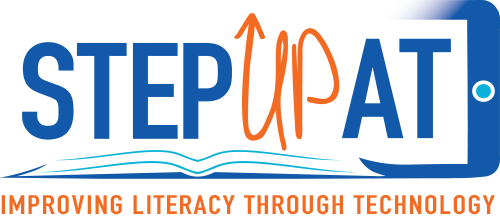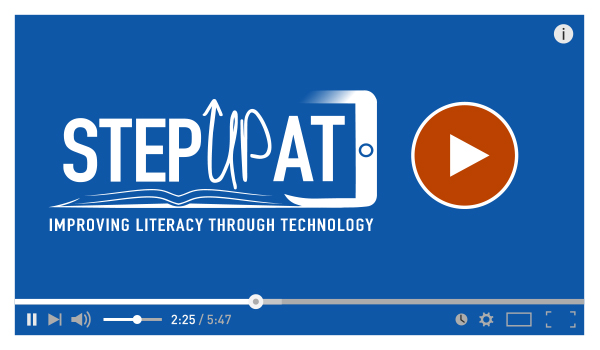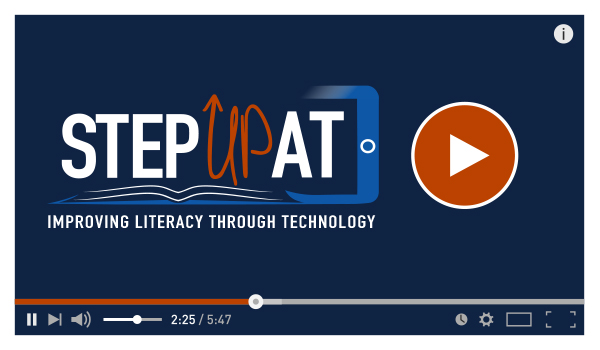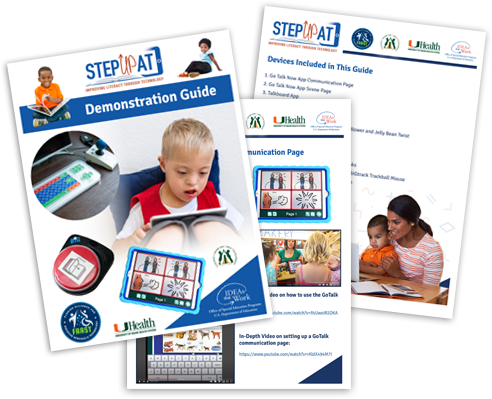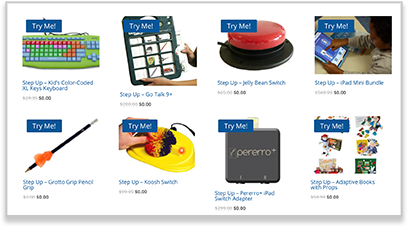Guided Learning at Home
Assistive Technology
Learn to use Assistive Technology at Home! We're here to help with our Guided Learning Program that walks you through how to use AT in everyday life.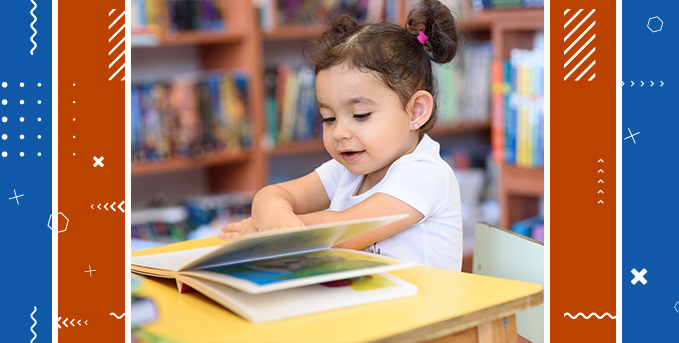
Part 1
Watch the videos below to understand the importance of shared literacy at home and how to use AT with your child.Now that you have the basics down, please continue through each of the videos below to learn more about different concepts of early literacy.
Use Words, More Words, and New Words
Help children expand their use of words by:
- Reading picture books
- Singing! Many songs have words not used in everyday conversation.
- Following the child’s interests, children learn new words best when they learn them in real-life settings (i.e. look for bugs in the playground, and then read a book about bugs.)
Hear Sound In Spoken Words
Help children expand their use of words by:
- Playing Word Games
- Singing
- Practicing Rhymes
- Exposing them to letters and the sounds they make.
Show Words Everywhere
Examples of Print Awareness Include:
- Point out the author and title of the book.
- Run your finger under a word or sentence as you are reading.
- Integrate reading and writing as part of another task such as writing a grocery list or writing a letter to your favorite storybook character.
- Make books together using a story the child has made up.
- Model use of print, such as making to-do lists.
Watch the videos to learn more about building vocabulary at home. Children will start recognizing the words they see around them.
Learn the ABCs
Everyday fun activities can help children learn their ABCs to master alphabetic principles.
Ways to Help Children Learn the Letters:
- Point out letters in the environment.
- Look at alphabet books.
- Make letters using playdough, paint, etc.
- Go on a letter hunt and search for a letter in books and magazines.
- Play “I Spy” and look for objects that start with a letter and sound it out.
Watch the videos below to learn more about letter knowledge at home.
Part 2
Watch the videos below to understand the importance of shared reading and adapting books.Incorporate Reading at Home
Tips to Incorporate Shared Reading at Home:
- Build children’s motivation and interest by designating a reading area.
- Offer a wide selection of books based on the child’s interests.
- Include props, puppets, felt boards, and costumes to be used during reading time.
- Allow the child to choose their favorite book.
Adapt Books At Home
Tips to Incorporate Adapting Books at Home:
Simple Book Adaptation helps make all the difference when you notice
- There is a lack of response to questions asked about a book.
- There is difficulty paying attention to a story.
Integrate assistive technology for adapting books in these videos.
Introducing Suitable Apps to Preschoolers
Considerations for Choosing Apps
- Is the app inviting to use, and does it inspire future use?
- Does the app open new ways to learn and let the child do things they haven’t been able to do before?
- Are the functions and designs of the app easy to use?
- Is the learning content appropriate?
- Strive to limit screen use to no more than 1 hour a day of high-quality programs/apps for preschoolers.
- Interactive engagement while using the app can help children integrate it with the world around them.
- Choose apps that are fun and support creativity, exploration, and play.
Part 3
Learn ways that you can use AT at home to inspire your child to develop their language.Low-Tech and High-Tech Supports
Using AAC In The Home:
Learn how to use Communication Devices to help children engage in communication throughout the day. The use of communication devices allows children to:
- Ask questions.
- Share their wants and needs.
Watch the videos to learn how to integrate low-tech and high-tech devices into the home environment.
Create Meaningful Interactions Through AAC
Augmentative and Alternative Communication (AAC) Tools and Strategies:
- Lack of opportunity to participate verbally may limit learning and keep a child from showing what they know.
- Children use meaningful interactions to learn how the world works and understand the meaning of words.
- AAC tools can provide children who are not yet talking, or talking very little, with an opportunity to express themselves.
- Any communication other than speaking is considered augmentative and alternative communication.
Watch the videos to learn more on AAC tools.
Part 4
Learn about AT tools that support children's vision and hearing, and provide access to the environment for children with motor difficulties.Vision
If your child has vision difficulties, you can use AT tools to:
- Adapt the home environment with room delineation by tactile area, reduce clutter on the floor and walls, use contrasts of simple colors and patterns, adjust lighting for the student.
- Adapt books and reading tasks with tactile books, raised-line or bold-line paper, or story boxes.
- Adapt writing tasks with textured papers, raised-line, or bold-line paper.
- Use iOS accessibility features and apps.
Writing Tools
Improving Experimental Writing Skills:
Experimental writing is an early literacy milestone and predictor of later reading and writing success. Through writing, children also learn:
- Print (alphabet knowledge).
- Letter Sounds (phonological awareness).
- Holding a book correctly.
- Understanding parts of a story.
- That words are read from right to left.
A child’s first writing attempts look like scribbles, but they usually know what they have “written”.
Hearing Impairment
Techniques for Improving Communication Skills:
Hearing difficulties can affect the ability to learn language and cause problems with early literacy development. Tips for improving communication include:
- Adapt the environment so it’s easier to listen to or follow a conversation.
- Use AAC and tools like assistive listening and personal hearing devices.
- Use iOS accessibility features and apps.
- Look directly at the child and face them while speaking.
- Say their name or get their attention in some way before speaking.
- Speak naturally and clearly and use facial expressions and gestures.
- Support social skills by teaching
View the videos to learn more about AT Tools that Support Hearing Difficulties and learn about how we can work with you for a similar device (opens in a new tab)..
Motor Difficulties
Provide Opportunities to Explore their Environment:
Caregivers should provide help but resist the temptation to do everything for the child, allowing the child to build self-confidence and gain control of their surroundings. Suggested strategies include:
- Making objects steadier (ex: use of non-slip mats to secure paper or blocks to the floor).
- Secure paintbrushes in a glove or provide paintbrushes with large knobs.
- Use spray bottles to practice squeezing motion (for using scissors).
- Keep items contained (ex: play with blocks on a cookie sheet).
- Use of switch-adapted toys, where the child presses a switch to activate a toy.
Switches are extremely effective and available for different purposes (finger switches, foot or head switches, button switches, textural coverings (soft fabric, squishy, bumpy).
Part 5
Support positive behavior through structure and predictibility throughout the day or during a specific activity.Provide Structure and Predictibility
Help preschoolers build on successes with Positive Behavior Supports:
- Assist with transitions, like when it is time to eat dinner, take a bath, or go to bed.
- Maintain learning routines.
- Attract and hold a child’s attention.
- Increase their understanding of spoken words using visual symbols
- Enable a child to focus on a message or situation through social stories.
Looking for More Resources?
Learn about how you can help your children reach their fullest potential through the use of assistive technology. We are always here to support you. Click on the images below to be directed to tools you can use immediately.AT to Help My Child At Home - Spanish
Click on the image above to learn how to help your child develop early literacy skills at home, in Spanish.
Parent Resources
Check out our Parent Resources to find out how to use AT to modify items in your home, available in both English and Spanish.
AT to Help My Child at Home - English
Click on the image above to learn how to help your child develop early literacy skills at home, in English.
